Girl Scout Cookies Auto Cannabis Strain Week-by-Week Guide

- 1. Grow specifications
- 2. Grow set up
- 3. Germination and seedling stage | week 1
- 4. Early veg | week 2
- 5. Mid veg | weeks 3-4
- 6. Transition (pre-flower) | week 5
- 7. Early flower | weeks 6-7
- 8. Mid flower (bulk phase) | weeks 8-9
- 9. Ripening and harvest | weeks 10–11
- 10. Yield and smoke report
- 11. In conclusion
Girl Scout Cookies Auto is a modern classic. Only a few years ago most growers worldwide could only dream of having this clone-only variety in their home garden. Now, this unique genetic with a smell of sweet cookies and a blissfully strong effect is available in seed form and as an autoflower.
This autoflowering cultivar has won the hearts of many growers for numerous reasons. Her renowned Cali genetics make her a force to be reckoned with. Among all of her desirable traits, her delicious terpene profile stands out the most. Every bong bowl or joint hit offers intense flavors of kush, earthiness, and sweet cookies. On top of this, her cannabinoid profile contains high levels of THC that catalyze a well-balanced high that soothes the body and stimulates the bind. Overall, she makes the perfect smoke for any time of the day. Use her for a jolt of cognitive energy during the morning, or to physically unwind in the evening.
With our GSC Autoflower week-by-week grow guide, we meant to demonstrate the ease of cultivating this wonderfully stable and resistant genetics. It’s based on an actual grow report of two Girl Scout Cookies plants that were cultivated and yielded 88 grams of trimmed dry buds in 11 weeks from seeds.
1. Grow Specifications
Compared with other Fast Buds cultivars, Girl Scout Cookies stays on the short side, generally reaching only 60–100 cm (24–39 inches) if left untrained. However, we suggest that you should low-stress train this autoflower, as she has long enough internodes and will benefit from tying down. This 60/40 Indica/Sativa hybrid has narrow leaves and sizable and very dense buds with a very beautiful combination of darker and lighter shades of green.
The yields are quite high at 450–600 gr/m2 (1.5–2 oz/ft2) indoors and 50–250 grams (2–9 oz) per plant outdoors, and the plants need only 9–10 weeks to get there. The buds and the sugar leaves sticking out of them are completely covered in resin and pack a hefty 20% THC as well as a lot of delicious terpenes. The finished product smells sweet and kush-like, with piney notes, while the taste of the smoke is earthy with hints of peppermint and, of course, cookie dough.

2. Grow Set Up
With stable genetics like Girl Scout Cookies, we didn’t spend much time looking for a representative grow report. All GSC Auto plants will have a more or less the same grow pattern as you can see in this week-by-week guide where two seeds were cultivated in a classic soil/perlite mix.
The grower ran his grow in a garage where he installed a 5’x5’ grow tent holding 2 Girl Scout Cookies and 2 other autoflowers. The tent was equipped with a 250W LED light, and the light schedule was 18/6 for the whole grow cycle.
| Grow Space: | 2.13 m2 (23 ft2) | Pot Size: | 11.36 l (3 gal) |
|---|---|---|---|
| Seed to Harvest: | 11 weeks | Medium: | Soil + perlite |
| Flowering: | 7 weeks | Nutrients: | Synthetic/Organic |
| Light Cycle: | 18/6 | pH Levels: | 6.4 |
| Light Type: | LED | Day Temperature: | 29–32°C (84–90°F) |
| Watts Used: | 250 | Humidity: | 50% |
3. Germination And Seedling Stage | Week 1
If you’re new to this game, we don’t recommend choosing a too complicated method of germination. The simplest ones work just as well. And when you grow autoflowers, make sure that you plant your sprout directly in the final pot. This ensures the least amount of stress and the fastest growth rates. Direct sowing benefits the root system during the early stages of growth. As opposed to germinating seeds in plugs or small pots, placing them directly in their final container allows the tap root to grow directly downwards uninterrupted. This results in a more stable and widespread root system early on in the growing cycle, which allows plants to absorb more water, uptake more nutrients, and team up with more beneficial microorganisms. All of these factors result in faster growth, healthier plants, and reduced chances of disease. Inoculate the initial growing medium with mycorrhizal fungi and rhizobacteria and you’ll place your seedling on the road to success very early on.
| Plant Height: | 2“ (5.1 cm) | Humidity: | 50% |
|---|---|---|---|
| Distance to Light: | 24“ (61 cm) | Water per Day: | 0.25 gal (0.95 l) |
| Day Temp: | 84°F (29°C) | pH: | 6.4 |
| Night Temp: | 79°F (26°C) | Smell: | None |
This was the first autoflower grow for our gardener so he decided to do everything ‘by the book’: no fancy HST methods and no transplants either. It was a good call because his autos were in for a lot of stress anyway: the grow cycle started on the 1st of June, so the guy had to deal with heat from day one till harvest. Temperature issues alone can stress and kill a weaker variety but not Girl Scout Cookies as it turned out.
He germinated his two seeds in jiffy plugs and when the seedlings were up, he put them into 3-gallon (11.36-liter) fabric pos filled with a soil/perlite mixture. Soil is the easiest medium for newbies because it doesn't require frequent watering like coco, contains enough nutrients for the first week or two, and when you start to add nutrients to your water, it doesn’t have to be an exact science. Unlike hydroponic setups, soil is more forgiving to wrong dosages and can buffer some extra nutrients if you have given too much of them. And if you use organic nutrients, you don’t even have to monitor pH.
So for the first week, Girl Scout ladies were only getting plain pHd water. One looked a bit runtier than the other, but basically, both were doing great.
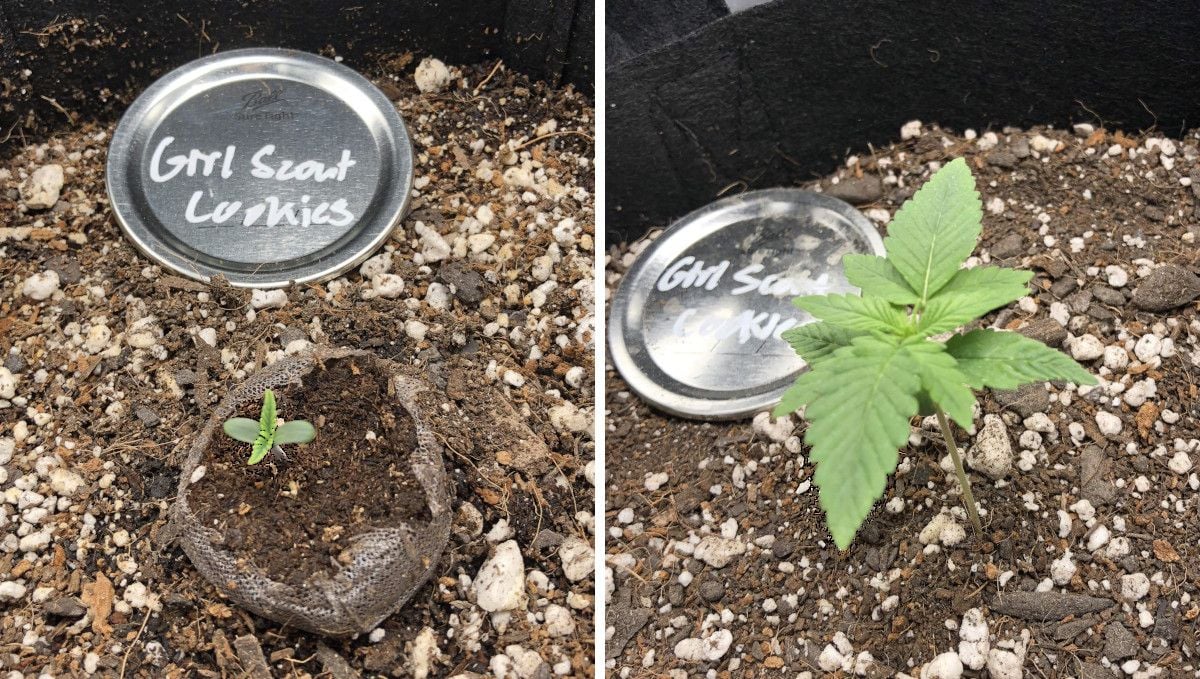
4. Early Veg | Week 2
The second week is the time when you can give your girls the first feeding, and it’s also important to adjust the distance from the light so that your seedlings don’t stretch out of control but also don’t get any yellowing due to light burn. However, there is some nuance involved when it comes to feeding during this time. It all really depends on the contents of your initial growing medium. Growers that add higher levels of well-finished compost to their blend won’t have to worry about feeding too much earlier on in the growing cycle, as their plants have access to a wide spectrum and nutrients.
| Plant Height: | 2“ (5.1 cm) | Humidity: | 50% |
|---|---|---|---|
| Distance to Light: | 24“ (61 cm) | Water per Day: | 0.05 gal (0.2 l) |
| Day Temp: | 90°F (32°C) | pH: | 6.4 |
| Night Temp: | 82°F (28°C) | Smell: | None |
However, growers that build their growing medium primarily using coco coir, peat, and other amendments that are low in nutrients will have to feed with either synthetic or organic liquid feeds to ensure their plants receive the nutrients they require during the early stages of growth.
With skyrocketing day temperatures (see the table above), it was a rough week. Nevertheless, the GSC twins looked much better than the two other autos in the tent. Another issue was fungus gnats. Unfortunately, hot (and humid) conditions often lead to pest infestation or make it worse. The guy had to use whole sheets of yellow sticky traps but he managed to get rid of the pesky critters. Even this didn’t slow down the Girls Scout Cookies, and they grew steadily and looked lush and green.
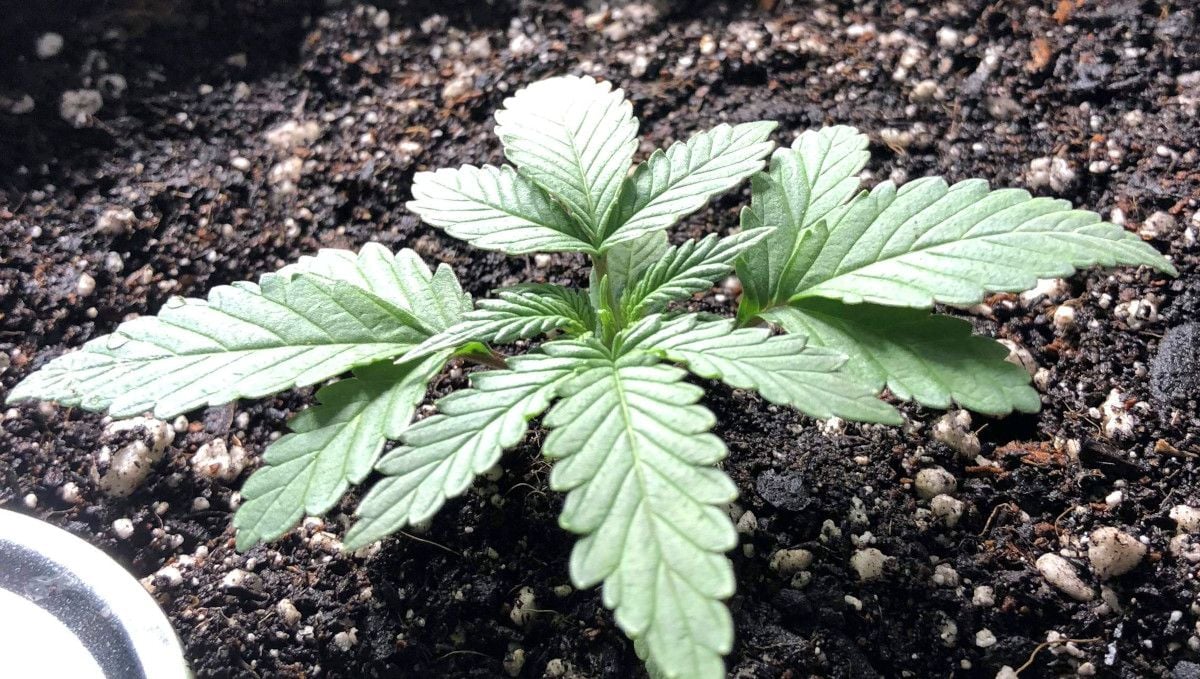
5. Mid Veg | Weeks 3-4
The second half of the first month in the life cycle of an autoflower is the period of super active, even explosive growth. This stage is called the vegetative phase. By this time, the root ball has more or less developed, and you’ll notice daily changes in the above-ground part of the plant. The main stalk and large fan leaves will keep growing, but more importantly, side branches will start to develop, and this is the perfect moment to start the training. Cannabis plants benefit from high levels of nitrogen during this phase of growth, as well as good amounts of phosphorus and potassium. As plants continue to develop the large fan leaves that they use for photosynthesis, their demand for nitrogen remains increased.
You see, these elements help to form amino acids—the building blocks for plant proteins. A deficiency in these nutrients means plants can’t produce tissue and enzymes as quickly as they need, which can result in symptoms such as stunted growth and yellowing leaves. Worm tea and liquid seaweed are great organic sources of nitrogen. Likewise, synthetic bottled nutrients also provide this element in a form that plants can rapidly uptake and use.
| Plant Height: | 5–7“ (12.7–17.8 cm) | Humidity: | 50% |
|---|---|---|---|
| Distance to Light: | 24“ (61 cm) | Water per Day: | 0.5 gal (1.9 l) |
| Day Temp: | 86°F (30°C) | pH: | 6.4 |
| Night Temp: | 82°F (28°C) | Smell: | None |
The trouble with the heat continued for this garden. Sometimes, the day temps climbed as high as 90°F (32°C). The is way outside the optimal range. When growing cannabis, think of what is comfortable to you which is about 77°F (25°C). Three-four degrees in either direction is alright, but when the air gets too cold or too hot, you yourself will feel discomfort, and so will your marijuana plants.
That’s why we advise not growing in summer indoors, especially if you use hot-running HPS lights. LEDs produce less heat, but in this case even with LEDs, it was obviously too hot. Fortunately for the grower, half the ladies in his grow tent (of course, we mean GSC) didn’t mind hot temps too much. The other autoflowers didn’t take it so well.
The grower began adding some nutrients to the water, but only a very small amounts at first – just a taste of what was coming:
- GHE G.O. Thrive Grow – a classic NPK formula to provide your cannabis’ needs by feeding beneficial microbes living in the root zone,
- GHE G.O. Root Plus – a mix of vitamins, humic acids, and other organic products to boost the growth of a healthy root structure,
- Blue Planet Nutrients Cal-Mag – an extra source of calcium and magnesium but also iron; all are very important for healthy growth, especially in coco but in soil as well.
He also started to low-stress train both by simply tying down the main stalks and securing them with braces.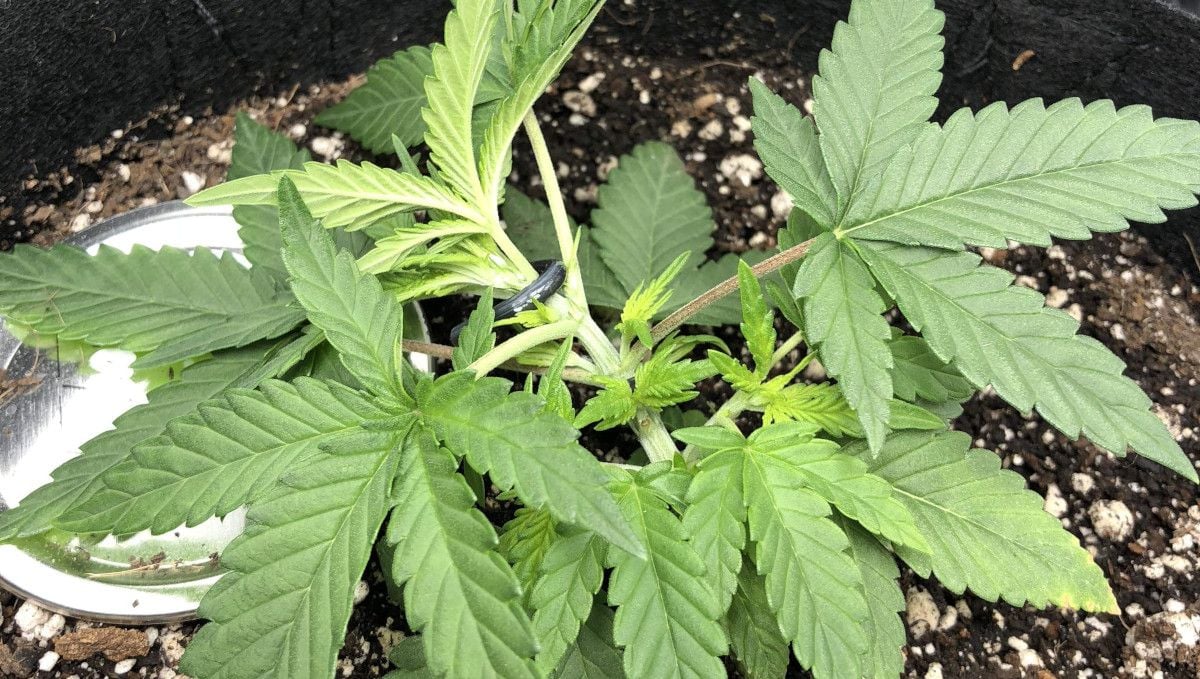
By the end of the first month, both girls were far along enough for the first pistils (female hairs) at the nodes to appear. It doesn’t mean that they were entering the flowering stage – they were just revealing their sex. Both were female and practically twins in appearance.
They have probably depleted all the nutrients stored in the soil by this time, so the grower began to feed them in earnest. And here’s the complete schedule for the whole of the life cycle right up to the final flush:

Both Girl Scout Cookies Autos were kept very close to the ground by aggressive LST, but as you can see in the picture, the tied-down tops were bouncing back almost immediately.
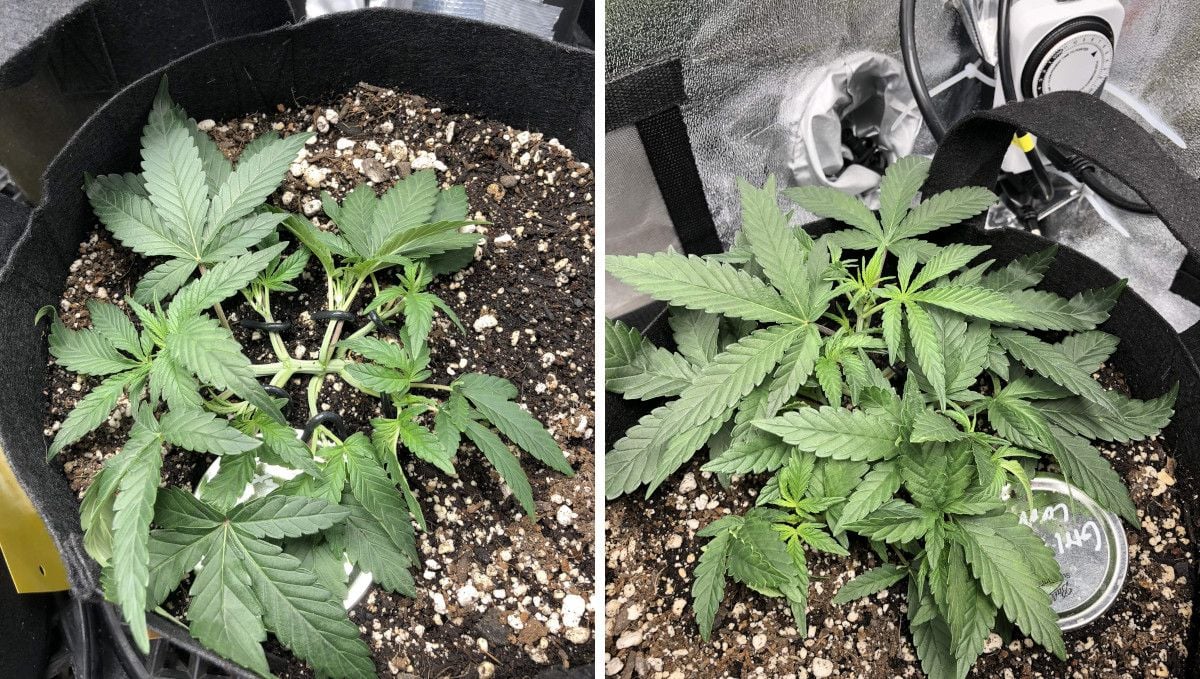
This is because of a group of plant hormones called auxins within the growing tips that direct growth toward the light. This goes to show that you have to stay on top of things when it comes to LST. Continue to tie down growing tips in a way that keeps the canopy even and level. This will help to expose all parts of your plant to equal levels of light.
6. Transition (Pre-Flower) | Week 5
Around week 5 from sprouts, most Fast Buds autoflowers finish their vegetative phase and begin the pre-flowering stage. You will notice the transition by the emergence of tiny female hairs, or pistils, first at the lower nodes – where side branches are attached to the stem – and then on the tops. Another sign is the change of color at the tops – the new leaves here are light-green and yellowish, contrasting with the darker hue of the foliage below. The little leaves on top also become very narrow, almost thread-like, and look almost the same as pistils.
| Plant Height: | 10“ (25.4 cm) | Humidity: | 50% |
|---|---|---|---|
| Distance to Light: | 24“ (61 cm) | Water per Day: | 1 gal (3.8 l) |
| Day Temp: | 88°F (31°C) | pH: | 6.4 |
| Night Temp: | 82°F (28°C) | Smell: | None |
The grower continued with LST all through the pre-flower week because he knew what would happen next – his Girl Scouts will start the flowering stretch and probably double in height. Indoors, you want to control the stretch and keep the canopy as flat as possible. The reason is that light intensity depends on the distance, so for taller plants, there will be a huge difference in texture between the uppermost buds and those down below: the upper buds will be big and dense, the lower ones wispy and weightless. But if you keep your canopy flat, all colas will be identical and of premium quality.
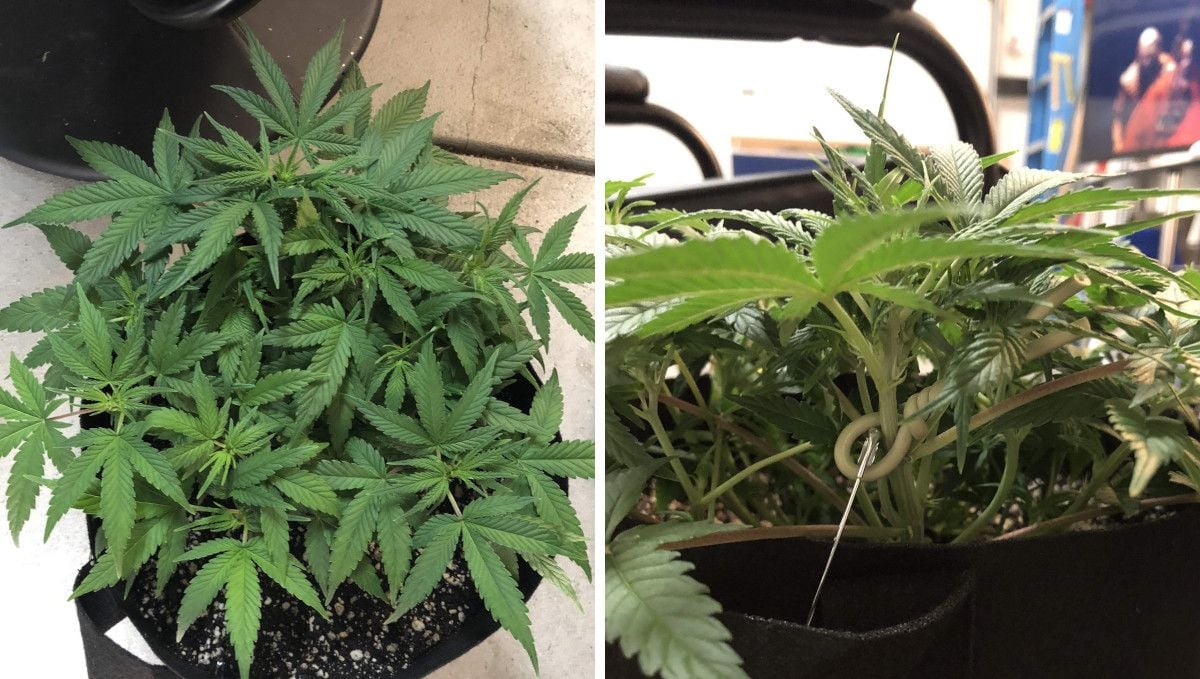
7. Early Flower | Weeks 6-7
The main thing that is happening in the first couple of weeks of flowering is, of course, the stretch. The main stalk and side branches become longer by the day, with the plant growing by at least 50 percent and sometimes 2-3 times. In a photoperiod grow, it could be a very unpleasant surprise for beginner growers who have kept their plants in veg for too long and now realize that they will stretch past the light and right into the ceiling.
With autos, things are much easier since most of them don’t veg for too long and start to flower when still quite short and compact. As you shall see, that was the case with these two GSC autoflowers. The grower even wished they stretched more.
| Plant Height: | 12–15“ (30–38 cm) | Humidity: | 50% |
|---|---|---|---|
| Distance to Light: | 20“ (51 cm) | Water per Day: | 1-1.25 gal (3.8-4.7 l) |
| Day Temp: | 90↘88°F (32↘31°C) | pH: | 6.4 |
| Night Temp: | 82°F (28°C) | Smell: | Weak |
In week 6 from seeds, a heatwave struck especially hard. It was unfortunate because, in flower, you don’t need high temps. They interfere with budding and make terpenes evaporate too fast. Btw, the grower reported only a weak aroma throughout the grow cycle. In this heat, the girls were drinking more than a gallon of water a day and started to receive a new kind of feeding. You can check out the nutrient schedule above (in the comments to week 4), and below is the list of the nutes and their short description.
- GHE FloraGro, FloraBloom & FloraMicro – a 3-part non-organic formula that provides cannabis with all three macronutrients (N-P-K) plus all lesser but essential stuff; also contains silicate to strengthen plants’ cell walls,
- GHE G.O. Bud – organic bloom stimulator to enhance the production of big, dense, and heavy flowers.
As you can see in the pic below, the buds started to form on tops, and both autos looked flat and almost identical in size and structure.

In week 7, things were on cruise control. The plants were receiving their food, light on nitrogen and heavy on phosphorus and potassium, because the latter two are needed the most in flower. And once the grower had started to give them a cal-mag supplement, he continued with it until the final flush.
The GSC twins still weren’t stretching much, had tight internodes, and they started to build the first trichomes very early. Now, in only the second week of flowering, the grower noticed that even stems were covered in trichs!

If you're interested about what you may expect from Girl Scout Cookies in terms of size, here's the complete height chart from week 1 to 8:
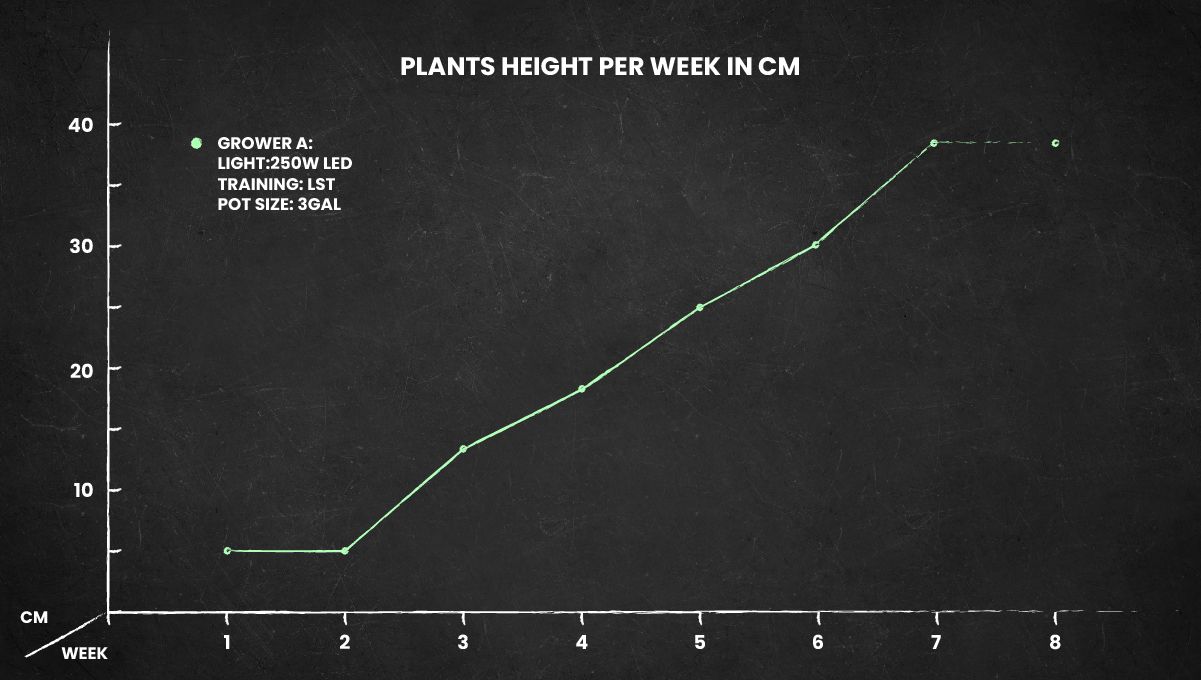
8. Mid Flower (Bulk Phase) | Weeks 8-9
Among the different stages of flowering, this is the one when cannabis is the hungriest and needs all the food you can give it to develop nice fat buds. By this point in the timeline, you have probably figured out how much nutes you can use without overfeeding and nutrient burn. The stretch has probably ended, but if you can, we suggest lowering the day temperature a bit – to something like 73–75 °F (23–24 °C). It’ll be more appropriate for cannabis flowering stages.
| Plant Height: | 15“ (38 cm) | Humidity: | 50% |
|---|---|---|---|
| Distance to Light: | 20“ (51 cm) | Water per Day: | 1.25 gal (4.7 l) |
| Day Temp: | 88°F (31°C) | pH: | 6.4 |
| Night Temp: | 82°F (28°C) | Smell: | Weak |
Since both the Girl Scouts were quite short and had a dense bush structure, the grower decided to defoliate them a bit. He had plucked a handful of fan leaves in the previous weeks, and now he removed some more. Both times lightly though because it was his first experience with autoflowers and he didn’t want to shock them with too high-stress techniques.
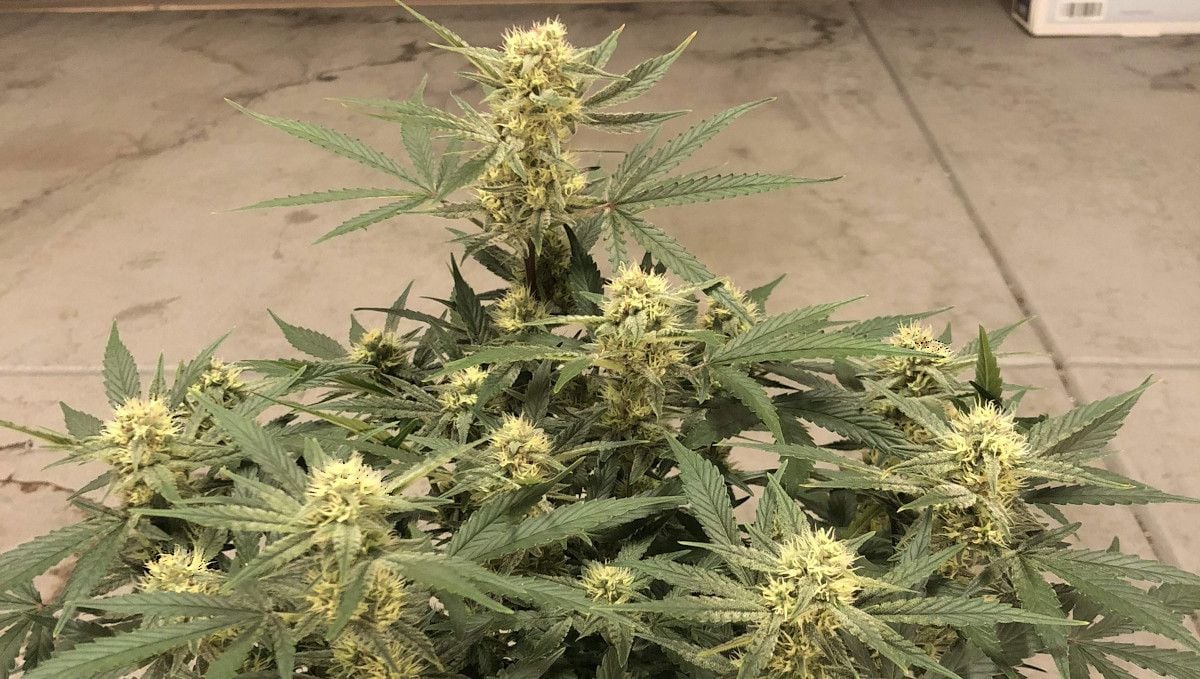
Both ladies promised to be way above average in the resin-production department (compared with the other two autos in the tent and even photoperiod plants from previous grow cycles). The slightly taller one seemed to be a little ahead and already had a few reddish pistils among greenish-white ones, and the buds were well stacked and dense on both ladies.

9. Ripening And Harvest | Weeks 10–11
In the last stage of the flowering time, gardeners don’t have to do much in terms of tending to their plants but they need to start to inspect them closely for the signs of maturity. It’s important not to miss the perfect window for starting the final flush.
| Plant Height: | 15“ (38 cm) | Humidity: | 50% |
|---|---|---|---|
| Distance to Light: | 20“ (51 cm) | Water per Day: | 1.25 gal (4.7 l) |
| Day Temp: | 90°F (32°C) | pH: | 6.4 |
| Night Temp: | 84°F (29°C) | Smell: | Weak |
The 10th week from seeds is the time when you will probably want to stop feeding your autoflowers and begin to flush them. However, it all depends on the state of the trichomes when seen with a hand microscope (a jeweler’s loupe). Young trichs start out clear, and as they mature, they will become cloudy. When most of them look cloudy and there are a few that have turned amber, it means that they have reached the peak of their maturity, so it’s harvest time. But you want to catch a moment when the clouding only starts and begin the process of flushing.
Note: When looking at the state of trichomes under a microscope, always choose those on a flower calyx and not on a sugar leaf. It’s because you’re interested in the maturity of buds and not leaves.
The gardener couldn’t help but admire his two frosty ladies and imagined what they could have been like if he only didn’t choose summer for his cycle. Despite constant heat, the girls looked vibrant and had a healthy green color throughout.
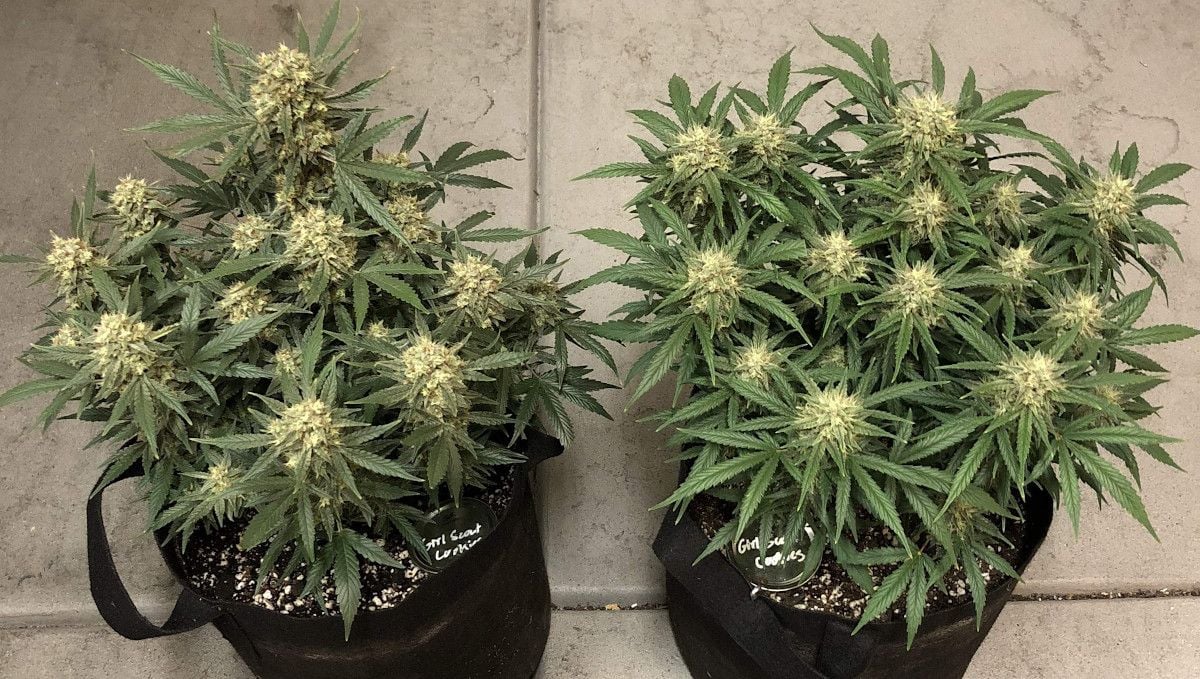
In week 11, the girls started to fade but only ever so slightly. Obviously, they had been well fed throughout the grow stages and the flowering phase. However, we would recommend making them a bit hungry for nitrogen (N) in flower by cutting on the N-rich products. The abundance of nitrogen in flower is known to interfere with bud development. Probably, the yield would have been bigger if the girls had more yellow leaves at harvest. Anyway, both were ready by day 75 or 76 and looked fabulous.
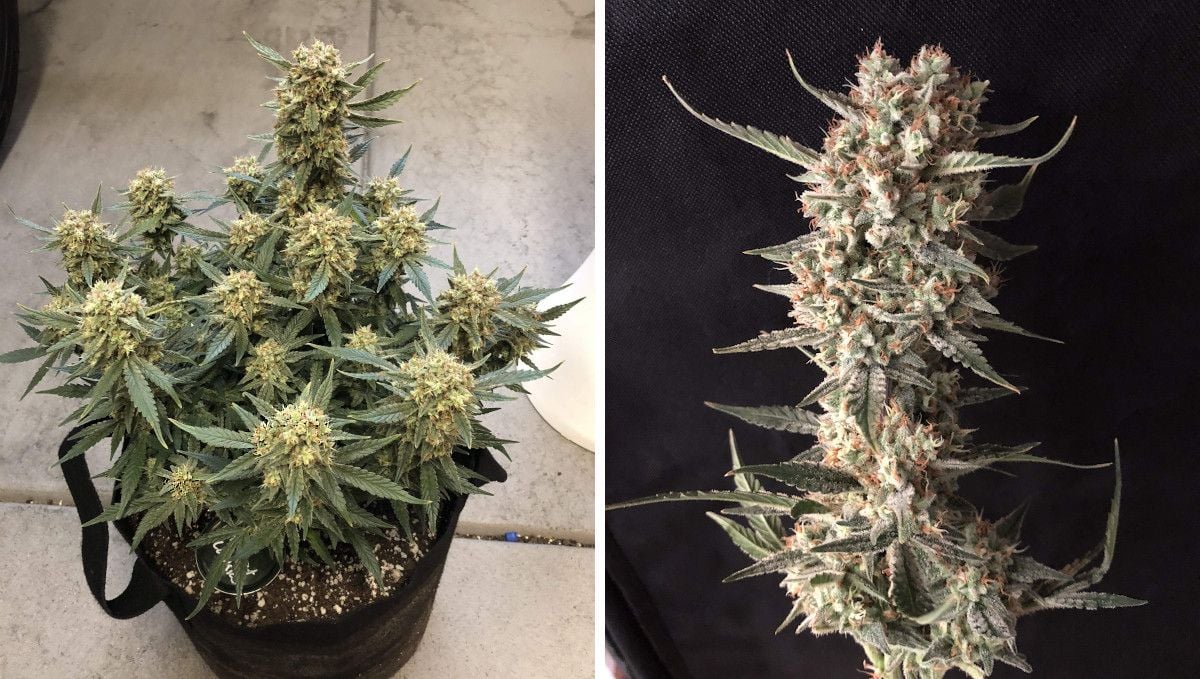
10. Yield and Smoke Report
It’s surprising to see plants grown from seeds perform like clones, but that’s what these two Girl Scout Cookies Autos did. One yielded 44 grams and the other 43, or 87 grams (3.1 oz) from two plants. One had slightly bigger buds, the other smaller but tighter and packing a bit more weight.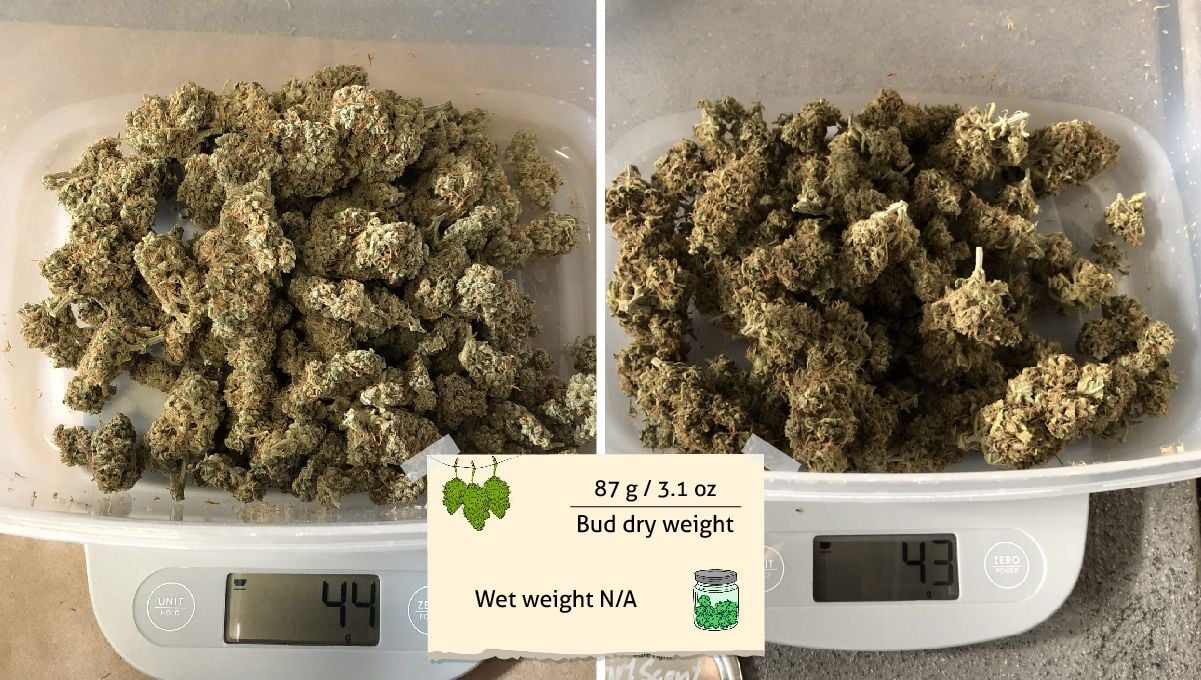
The buds were frosty and produced a strong high with lots of euphoria and heavy eyelids – more suitable for nighttime use. The gardener described the effect as leaning 85% on the Indica side. The flavor was dominated by flowery and herbal notes but wasn’t too strong, probably because of the heat issues throughout the grow.
11. In Conclusion
In this run, Girl Scout Cookies Auto proved a very stable and hardy variety. It’s a huge plus when plants cultivated from seeds remind clones in their uniform growth patterns, especially if you have several of them in one tent. Resistance to heat is also a feature that’ll come in handy in many indoor setups – most of them run too hot despite all efforts to bring down the temps.
Huge resin production is another of the strain’s highlights. As you could see, trichomes start to appear early and cover not only calyces and trim leaves but also stems. You can expect even more frost with cooler day and time temperatures. Otherwise, Girl Scout Cookies seems like a low-maintenance cultivar that reacted very well to the stable pH of 6.4 for the whole cycle and performed great with a quite simple nutrient schedule. All this makes our GSC Auto one of the best options for first-time growers who still want above-average yields and a great quality of smoke. Happy growing!
External References
- Temperature response of photosynthesis in different drug and fiber varieties of Cannabis sativa L., Physiology and Molecular Biology of Plants, July 2011
- Closing the Yield Gap for Cannabis: A Meta-Analysis of Factors Determining Cannabis Yield, Rachel Backer et al., Frontiers in Plant Science, 24 April 2019










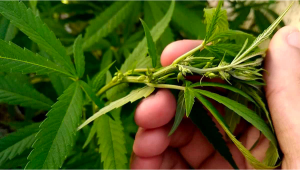


Comments